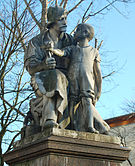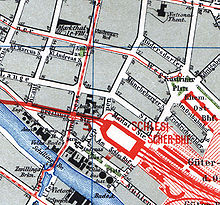Andreasplatz
| Andreasplatz | |
|---|---|
| Place in Berlin | |
 Andreasplatz 1899 |
|
| Basic data | |
| place | Berlin |
| District | Friedrichshain |
| Created | 1865 |
| Newly designed | Dedicated around 1960 |
The Andreasplatz was a former center of Stralauer suburb a historically significant place in today's district of Friedrichshain in Berlin . It was on Andreasstrasse , between the two cross streets Kleine Andreasstrasse and Grüner Weg (today Singerstrasse). Around 1960 the square disappeared from the cityscape with the redevelopment of the district.
History and meaning
Market square in the Stralau suburb
The Andreasplatz got its name on March 25, 1865, because it was located on Andreasstrasse. Just like the Kleine Andreasstraße, both are named after the apostle Andreas , as the St. Andrew's Church, which was destroyed in the Second World War, was at the southern end of Andreasstraße, Stralauer Platz . The Andreasgemeinde in the Stralau quarter existed already since 1853. In the planning of the Stralau quarter, however, the place was only listed as place D.
Until 1888, the regular weekly markets of the Stralau district took place on Andreasplatz, with 594 individual market stalls being recorded around 1880. The last market day on the square was on April 27, 1888 and was then moved to Market Hall VIII, which opened on May 1, 1888, in the immediate vicinity on Kleine Andreasstrasse. However, the square remained the central meeting point of the district.
Optical upgrade and Zillekiez
On April 9, 1896, the Berlin city council decided to give the square an artistic design and thus upgrade it. A semicircular, monumental bench with a high back, flanked by two sculptures, was planned to be erected behind a fountain. The former town planner Hermann Blankenstein , who was no longer in office at the time, was commissioned to design the building . The foundations had already been completed in November 1896, but the creation of the marble groups on the side was delayed. On November 26th, a bronze relief medallion of Borussia (an allegorical female figure on the state of Prussia ) by the sculptor Reinhold Felderhoff was integrated centrally into the high seat back. The two sculptures were completed and erected in 1898.
The sculptures created two portraits that were supposed to be visually linked to the residents of the district and were therefore atypical for the Wilhelminian era , when it was mainly nobles who were given sculptures:

|

|
|
|
Wilhelm Haverkamp : craftsman with son
|
Edmund Gomansky : mother with child ; in the Volkspark Friedrichshain .
|
The sculpture on the right, created by Edmund Gomansky and known as the Mother Group, was intended to represent the bourgeois ideal of the housewife, wife and mother during the imperial era. It is a female figure with a sleeping child in her lap, the artist consciously using the model of historical Madonna icons. The sculpture on the left was created by Wilhelm Haverkamp as a portrait of a seated craftsman with his son, known as the father group. This is the only known monumental worker statue from the Wilhelmine era, which caused the sculpture to attract particular attention. It shows a worker with a blacksmith's apron taking a break from work and his son, who reaches for the hammer to symbolically remove the hammer from his father's role model and continue in his tradition. The portrait idealizes the worker in a romantic way, and the contemporary magazine “Der Bär” wrote: “The picture glorifies the beauty that blossoms out of strength and hard work” . As a result, the proverbial worker statue in Berlin was derived from this sculpture. It is still used to this day to refer to a worker who rests on his tool, such as a shovel.
However, the square did not develop into a representative area, but rather, in accordance with the residents and the structure, into a neighborhood square in the middle of the well-known Zille milieu . Heinrich Zille never described the squares and houses directly, but, coming from Dresden, grew up on Kleine Andreasstrasse after 1867 and lived in the middle of the tenements around Andreasplatz. These became the main subject of his later works. The Andreasplatz also developed into a center of the Berlin red light district around the former Schlesischer Bahnhof, today's Ostbahnhof . The well-known Berlin serial killer Carl Großmann also lived near the square and was also looking for his victims here, mostly prostitutes and penniless women.
Dissolution of the square around 1960
Around 1960, when the district was rebuilt, Andreasplatz disappeared completely from the cityscape. There is now a retail building on the former open space of the square. Only the intersection of Andreasstrasse and Singerstrasse is still called this. The bench was removed and the two sculptures moved to separate locations. The father group can be found diagonally across from what was then Andreasplatz, isolated on a meadow at the rear of the Andreasgymnasium built by Ludwig Hoffmann . The mother group stands in the Volkspark Friedrichshain in the extension of Virchowstrasse and thus behind the women's ward of the Friedrichshain hospital , which also puts them into a new context. The two sculptures are the last surviving monuments from the Wilhelmine era in Friedrichshain.
literature
- Jan Feustel : Vanished Friedrichshain. Buildings and monuments in the east of Berlin. Material accompanying the exhibition, Friedrichshain Local History Museum . Agit-Druck, Berlin 2001, ISBN 3-935810-01-6 .
- Kathrin Chod u. a .: Berlin district lexicon Friedrichshain-Kreuzberg . Haude & Spener, Berlin 2003, ISBN 3-77590-474-3 .
Web links
- Andreasplatz. In: Street name lexicon of the Luisenstädtischer Bildungsverein (near Kaupert )
Individual evidence
- ↑ a b Mende 2003 and mother with child in the district lexicon of the Luisenstädtischer Bildungsverein
- ↑ a b Mende 2003 and craftsman with son in the district lexicon of the Luisenstädtischer Bildungsverein
- ↑ quoted from Feustel 2001
- ^ The groups on Andreasplatz in Berlin . In: The Bear . tape 26 , no. 10 . Berlin March 10, 1900, p. 167 ( zlb.de ).
- ↑ Berlin Words from A – Z ( Memento from December 4, 2008 in the Internet Archive )
Coordinates: 52 ° 30 ′ 53.5 " N , 13 ° 25 ′ 53.5" E

